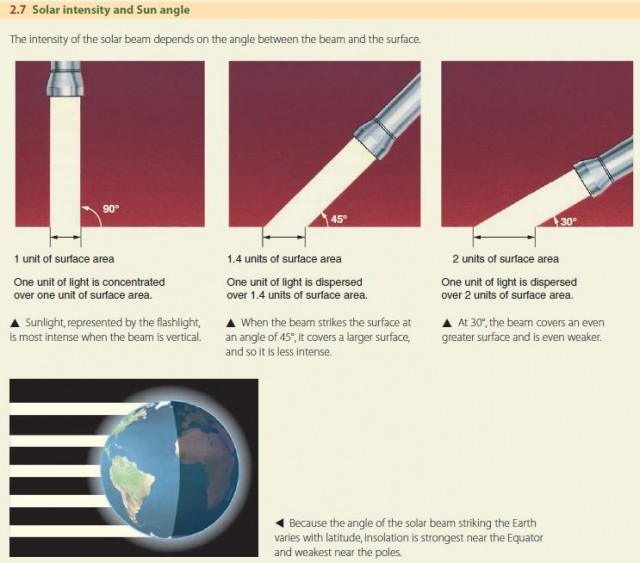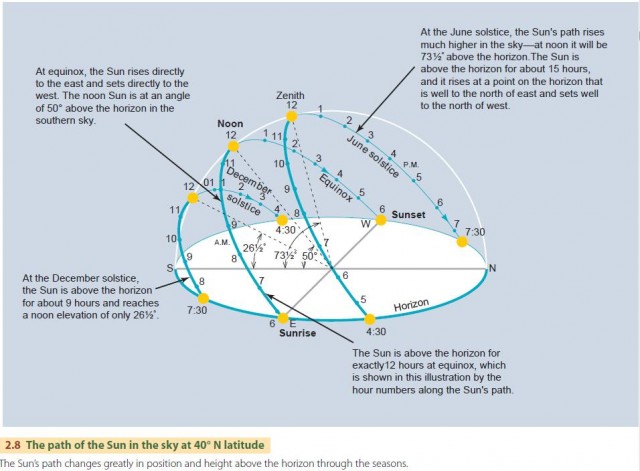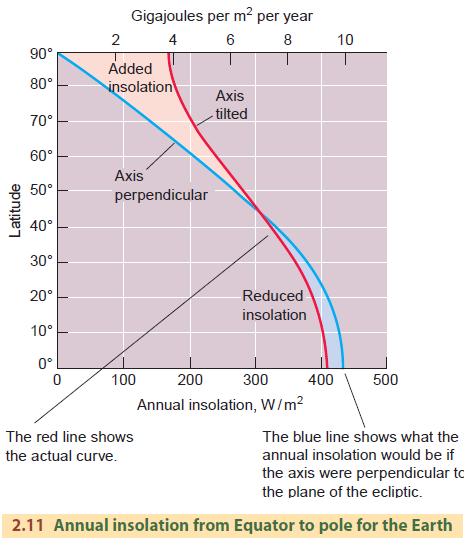Insolation over the Globe
Most natural phenomena on the Earth's surface—from the downhill flow of a river to the movement of a sand dune to the growth of a forest—are powered by the Sun, either directly or indirectly. It is the power source for wind, waves, weather, rivers, and ocean currents, as we will see here and in later chapters.
Although the flow of solar radiation to the Earth as a whole remains constant, different places on the planet receive different amounts of energy at different times. What causes this variation? Incoming solar radiation is known as insolation. It is a rate of flow of energy and is measured in units of watts per square meter (W/m2). Daily insolation is the average flow rate over a 24-hour day, while annual insolation is the average flow rate over the entire year.
Insolation depends on the angle of the Sun above the horizon. It is greatest when the Sun is directly overhead, and it decreases when the Sun is low in the sky, since the same amount of solar energy is spread out over a greater area of ground surface (Figure 2.7).

DAILY INSOLATION THROUGH THE YEAR
Daily insolation at a location depends on two factors: (1) the angle at which the Sun's rays strike the Earth, and (2) how long the place is exposed to the rays. In Chapter 1 we saw that both of these factors are controlled by latitude and the time of year. At midlatitude locations in summer, for example, days are long and the Sun rises to a position high in the sky, heating the surface more intensely.
How does the angle of the Sun vary during the day? It depends on the Sun's path. Near noon, the Sun is high above the horizon—the Sun's angle is greater, and so insolation is higher. Figure 2.8 shows the typical conditions found in midlatitudes in the northern hemisphere, for example, at New York or Denver. An observer standing on a wide plain will see a small area of the Earth's surface bounded by a circular horizon. The Earth's surface appears flat, and the Sun seems to travel inside a vast dome in the sky.

Comparing the three paths shown in the figure, we find that both the length of time the Sun is in the sky and the angle of the Sun during the main part of the day change with the time of year. At the June solstice, average daily insolation will be greatest, since the Sun is in the sky longer and reaches higher elevations. At the December solstice, daily insolation will be least, with a shorter daily path and lower elevations. At the equinox, the insolation will be intermediate.
Figure 2.9 shows the Sun's path for three other latitudes. At the North Pole, the Sun moves in a circle in the sky at an elevation that changes with the seasons. At the Equator, the Sun is always in the sky for 12 hours, but its noon angle varies through the year. At the Tropic of Capricorn, the Sun is in the sky longest and reaches its highest elevations at the December solstice.

Based on this analysis, daily insolation will vary strongly with season at most latitudes. As shown in Figure 2.10, daily insolation at 40° will range from about 160 W/m2 on the December solstice to about 460 W/m2 on the June solstice. Insolation drops to zero at the North Pole at the September equinox, when the Sun's circular path sinks below the horizon, and does not increase again until the March equinox. However, the peak insolation at the June solstice is greater at the North Pole, about 500 W/m2, than at any other latitude. At the Equator, daily insolation varies from about 380 W/m2 to about 430 W/m2 and there are two maximums—each near the time of an equinox, when the Sun is directly overhead at noon. At the solstice, insolation is lower because the Sun's path is lower in the sky (Figure 2.9).

ANNUAL INSOLATION BY LATITUDE
How does latitude affect annual insolation—the rate of insolation averaged over an entire year? Figure 2.11 shows two curves of annual insolation by latitude—one for the actual case of the Earth's axis tilted at 23 ?° and the other for an Earth with an untilted axis. Let's look first at the real case of a tilted axis. We
can see that annual insolation varies smoothly from the Equator to the pole and is greater at lower latitudes. But high latitudes still receive a considerable flow of solar energy—the annual insolation value at the pole is about 40 percent of the value at the equator.

Now let's look at what would happen if the Earth's axis was not tilted. With the axis perpendicular to the plane of the ecliptic, there are no seasons. Annual insolation is very high at the Equator because the Sun passes directly overhead at noon every day throughout the year. Annual insolation at the poles is zero because the Sun's rays always skirt the horizon.
We can see that without a tilted axis our planet would be a very different place. The tilt redistributes a very significant portion of the Earth's insolation from the equatorial regions toward the poles. So even though the pole does not receive direct sunlight for six months of the year, it still receives nearly half the amount of annual solar radiation as the Equator.
WORLD LATITUDE ZONES
The seasonal pattern of daily insolation provides a convenient way to divide the globe into broad latitude zones that we will use in this book. The equatorial zone encompasses the Equator and covers the latitude belt roughly 10° north to 10° south. Here the Sun provides intense insolation throughout most of the year, and days and nights are of roughly equal length. Spanning the Tropics of Cancer and Capricorn are the tropical zones, ranging from latitudes 10° to 25° north and south. A marked seasonal cycle exists in these zones, combined with high annual insolation.
Moving toward the poles, we come to the subtropical zones, which lie roughly between the latitudes 25° to 35° north and south. These zones have a strong seasonal cycle and a large annual insolation. The midlatitude zones are next, between 35° and 55° north and south latitude. The length of daylight varies significantly from winter to summer here, so seasonal contrasts in insolation are quite strong. As a result, these regions experience a large range in annual surface temperature.
The subarctic and subantarctic zones border the midlatitude zones at 55° to 60° north and south latitudes. The arctic and antarctic zones lie between latitudes 60° and 75° N and S, astride the Arctic and Antarctic Circles. These zones have an extremely large yearly variation in day lengths, yielding enormous contrasts in insolation over the year. Finally, the north and south polar zones range from about 75° latitude to the poles. They experience the greatest seasonal insolation contrast of all, and have 24-hour days or nights for much of the year.